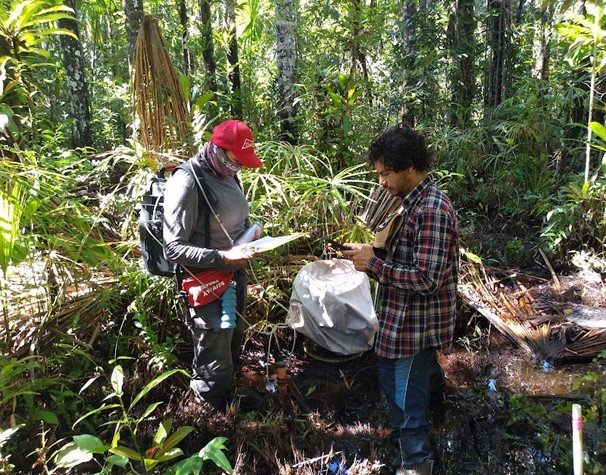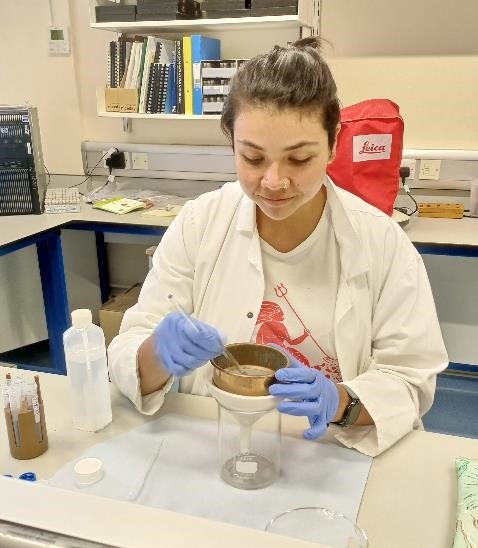Cycle 9 (2020 Deadline)
Climate mitigation potential of Colombia’s lowland peatlands: distribution, emission factors and conservation priorities
PI: Juan Benavides (jubenavides@javeriana.edu.co), Pontificia Universidad Javeriana
U.S. Partner: Erik Lilleskov, U.S. Forest Service
Project Dates: April 2021 - April 2024
Project Overview
 | | Researchers Paola Alarcon (left) and Alejandro Delgado measuring CO2 and CH4 soil fluxes in flooded forests with peat soils in the Colombian Amazon. Photo courtesy Dr. Benavides |  | | Paola Alarcon in the soil sample preparation workshop for C-14 dating of peat samples from the Amazonian peatlands at the University of Exeter | |
Peatlands are the most carbon dense terrestrial ecosystems, harboring several times the carbon of non-peatland tropical rainforests per unit area. In addition, they are a major sink for greenhouse gases, with global peatlands storing the equivalent of pre-industrial stocks of atmospheric carbon dioxide in just 3% of the land surface. However, these carbon stocks are vulnerable to land use changes (especially drainage) and consequent decomposition and burning, as well as to the warming and drying impacts of climate change.
Colombia has extensive lowland areas that are known to harbor peatlands, yet very little research has been done to characterize their extent and threats from land use/land cover change, disturbance, and climate change. Global mapping estimates suggest Colombia has about 75,000 km2 of peatlands, second only to Brazil in South America, yet this estimate has not yet been validated by ground truthing Deforestation is also substantial in this region, and both forest fragmentation and fire can have major impacts in the lowlands of Colombia. Because of the lack of information on peatlands, however, the intersections of these land use change and disturbances with peatlands is virtually unknown. This PEER project aimed to fill that gap, using a combination of remote sensing and ground truthing. The team also sought to estimate carbon stocks in these peatlands and gather data on greenhouse gas fluxes.
Final Summary of Project Activities
The PI Dr. Benavides and his group developed the first detailed map of peatlands covering a variety of vegetation types in the Amazonian Trapezium region, providing an invaluable tool for the precise identification of wetlands within the Amacayacu National Natural Park and for the formulation of effective conservation strategies. The researchers have identified new types of peatlands with diverse vegetation forms that had not been previously documented and are widespread across the entire Amazon region. These sites, in addition to their ecological richness, pose significant logistical challenges due to their remote location and security concerns associated with accessing them. The team was also able to quantify large soil carbon stocks and the initial CH4 and CO2 greenhouse gas fluxes produced by these peatlands under a biogeochemical gradient in the Amazon region of Colombia.
As part of the mapping activities, the team conducted visits to areas such as the Rey Zamuro Reserve located in San Martín, Meta, where extensive palm swamps were found associated with small water tributaries. Other visits were carried out within the Casanare Department on the premises of a civil reserve called La Aurora. The team processed more than 30 cores using the loss ignition methodology to determine carbon percentage and content and bulk density from the samples taken from Amazonas, Vaupes, and Caquetá. For CO2 and CH4 monitoring, field trips were conducted to intensive monitoring sites in Inirida, Leticia, and Puerto Lleras.
The PEER team took part in a one-month laboratory training at the University of Exeter in England to learn about the methodologies used in paleoecology, as well as workshops on methane emission modeling in tropical peatlands and data analysis. Their data and monitoring methodology are now included in the greenhouse gas budgets originating from natural systems in the Colombian Amazon region. By the time of their final report in May 2024, the team had received three additional grants worth a total of $150,000 to continue their work. Publication of their findings is forthcoming.
Back to PEER Cycle 9 Grant Recipients
| 




